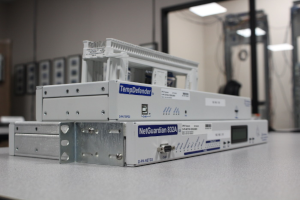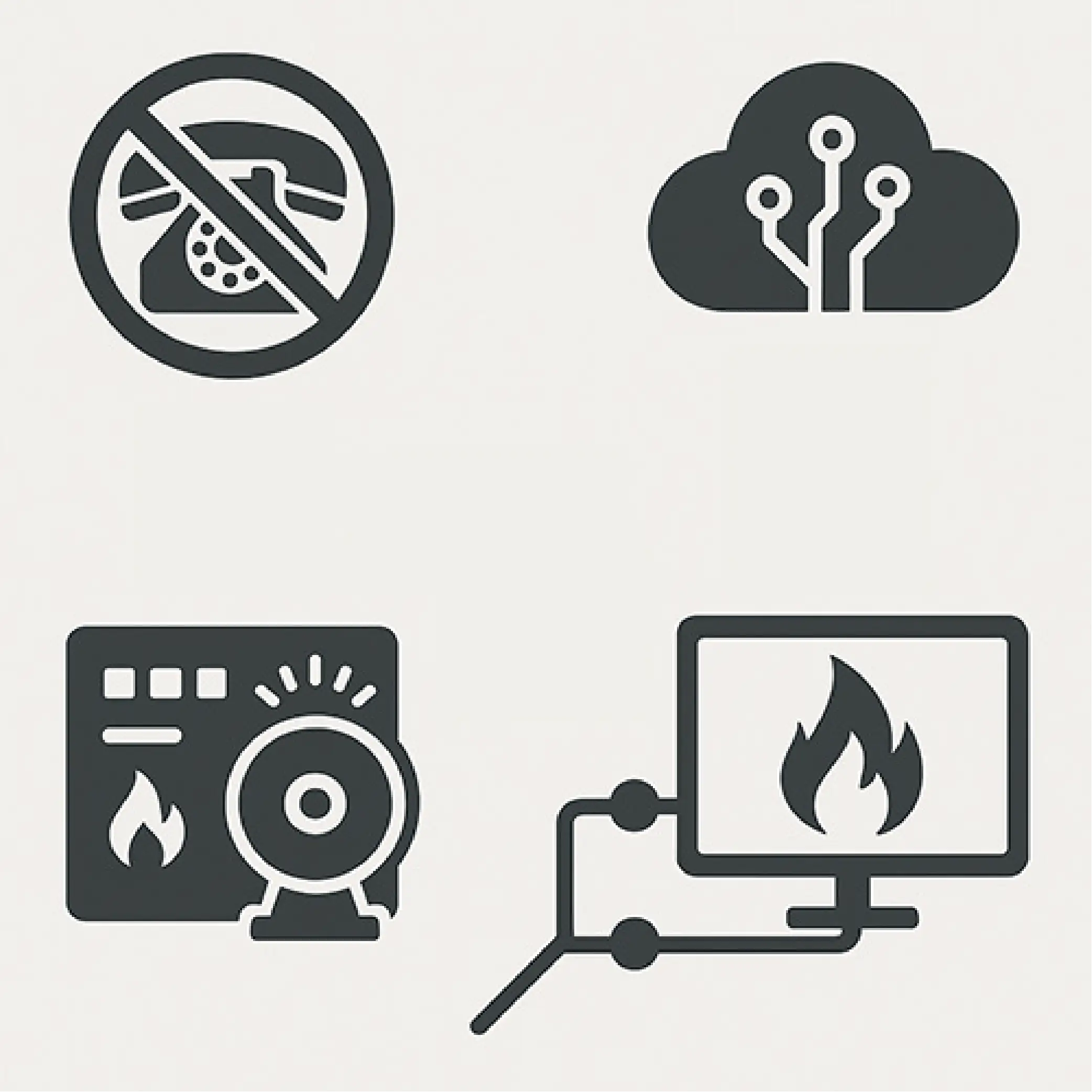Check out our White Paper Series!
A complete library of helpful advice and survival guides for every aspect of system monitoring and control.
1-800-693-0351
Have a specific question? Ask our team of expert engineers and get a specific answer!
Sign up for the next DPS Factory Training!

Whether you're new to our equipment or you've used it for years, DPS factory training is the best way to get more from your monitoring.
Reserve Your Seat TodayIf your facility still relies on a legacy dial-up (POTS) fire alarm communicator - also known as a DACT - you're not alone. But the window for safely using those devices is closing faster than many realize as phone companies transition to VoIP service only.
In the last several months, we've spoken with many clients who are facing the same issue: their DACTs are either failing outright, or operating on a changing phone network that no longer guarantees reliable signal transmission of analog tones.
This is more than a nuisance. It's a threat to life safety and regulatory compliance.
So the question becomes:
What happens when the infrastructure your fire alarm system depends on is no longer there?
I'm going to walk you through the current state of dialer technology, where it's failing, what alternatives actually solve this new problem, and how you can upgrade - without getting stuck paying unnecessary third-party fees forever.

DACTs (Digital Alarm Communicator Transmitters) were originally built to work over PSTN analog telephone lines (POTS). That infrastructure was the only phone option in commercial, military, and municipal facilities for decades.
The basic operation was simple: when the fire panel detected an event, the DACT dialed a receiver at a central station and transmitted the alarm in a standardized format.
This was a time-tested model. However, today, this is quickly becoming obsolete for two critical reasons:
As a result, DACTs that once worked flawlessly are now failing unpredictably. This creates dangerous blind spots in your monitoring infrastructure.
So what do most fire alarm contractors or FACP dealers recommend when a dialer stops working?
You probably know the answer:
"Just replace it with a cellular communicator or an IP transmitter."
These newer devices do work over modern networks, and they're UL-listed for fire alarm communication. However, there's a catch that, while obvious, you may not fully appreciate at first:
These devices rely on third-party services to transmit the alarm signal.
Instead of sending alarm data directly to your fire alarm receiver or central station, these communicators use a third-party provider (like your wireless provider) to receive, process, and forward your signals - usually over a managed network. This has two significant downsides:
Just like in the days of POTS lines, third-party providers typically charge for one or both of the following:
In facilities with dozens or hundreds of transmitters, these fees can easily exceed five figures annually.
Once your alarms pass through a third-party system, you have little visibility into the process. If a message is delayed or dropped, troubleshooting can be complex - especially if you're trying to prove compliance after the fact.
In some high-security and/or high-reliability industries (military, municipal, transportation), this lack of control can be a deal-breaker.
For a better way to think about alarm communication in 2025 and beyond, consider:
What if you could transmit your fire alarm signals directly - without involving a cellular network, third-party service, or extra fees?
Many facilities already have the infrastructure to make that happen. You just need to think about it differently. Instead of outsourcing alarm delivery, you'll use existing (or easily installed) infrastructure to handle it in-house.
Some common examples we've seen with recent clients include:
If your buildings are already connected via fiber or internal Ethernet, you can install alarm communicators that talk over IP - without leaving your network or paying a third party.
Even older copper connections can be repurposed for serial or twisted-pair communications, depending on the distance and shielding.
Where hardline connections don't exist, private point-to-point wireless systems can create secure and reliable links between buildings or campuses. These setups are especially common in municipal complexes and military installations.
In all of these scenarios, the cost is upfront and one-time - rather than recurring. Once installed, the system belongs to you.
At Digitize, we've spent decades working with facilities that want more control over their fire and security monitoring systems. And one consistent goal we hear is:
"We want to get off the hook for third-party alarm fees."
Our systems help you do exactly that in a few key ways.
The Prism LX is a powerful, UL-listed alarm receiver that sits at the center of your fire alarm monitoring system. It accepts alarm signals directly from:
So, what does that mean? You can connect your alarm transmitters without routing anything through a commercial cellular network or third-party hub.
More importantly, you control the entire communication path - from the panel to the Prism LX head-end.
If you're still using older FACPs that don't natively support modern protocols, we offer Mediator modules that convert their outputs into usable formats for the Prism LX.
Instead of replacing an entire fire panel, you just retrofit the communication layer - and gain years of extra service life.
Whether you're using a municipal fiber backbone, a military base's hardened Ethernet network, or a school district's private WAN, Digitize devices can be configured to use your internal infrastructure.
This eliminates the need for expensive alarm-over-cellular plans and gives your IT or facilities team the visibility they need to troubleshoot quickly.
If your facility is still running dial-up DACTs or has already replaced some with fee-based cellular units, it's time to take another look at your entire alarm communication model.
Start by asking these key questions:
You might find that the return on investment for a self-contained Digitize system is shockingly fast - sometimes less than 12 months.
For many facilities, end-user teams are becoming more involved in day-to-day alarm monitoring. Our clients increasingly prefer in-house control, with local training provided during system commissioning. This advantage adds to your ROI by giving you a performance/reliability advantage.
Of course, fire panel dealers and alarm contractors are still part of the picture, but their role becomes more collaborative. They focus on installation and annual inspections rather than managing all system operations.
One municipal client recently faced a common scenario: their city hall, police station, and firehouse each had DACTs that were increasingly unreliable. Their telecom provider had moved to VoIP and could no longer guarantee analog line performance.
The initial suggestion was to install three separate cellular alarm communicators (each with its own monthly service plan!).
Looking for a better way, they contacted Digitize and implemented a Prism LX receiver at the emergency services hub. Using the city's existing internal network, they connected each building via IP-based alarm communicators. Their result involved having:
That's the kind of long-term upgrade that saves both money and headaches.
There's no shame in still having a dial-up communicator on your fire panel. These systems worked reliably for years, and many facilities have squeezed every ounce of value from them.
But in 2025 and on, continuing to rely on legacy dialers is becoming a gamble - especially when their supporting infrastructure is disappearing.
Luckily, you don't have to settle for expensive third-party alternatives. With modern options like the Digitize Prism LX, Mediators, and IP-based alarm reporting, you can "future proof" your fire alarm monitoring without adding monthly fees to your budget.
If you're planning an upgrade - or just trying to understand your options - Digitize can help you. We've worked with:
We'll help you build a reliable, cost-effective, and fully owned alarm monitoring system that's tailored to your infrastructure.
Call 1-800-523-7232
Or email info@digitize-inc.com
Let's make sure your next alarm signal is fast, reliable, and doesn't require monthly fees.

Andrew Erickson
Andrew Erickson is an Application Engineer at DPS Telecom, a manufacturer of semi-custom remote alarm monitoring systems based in Fresno, California. Andrew brings more than 18 years of experience building site monitoring solutions, developing intuitive user interfaces and documentation, and opt...